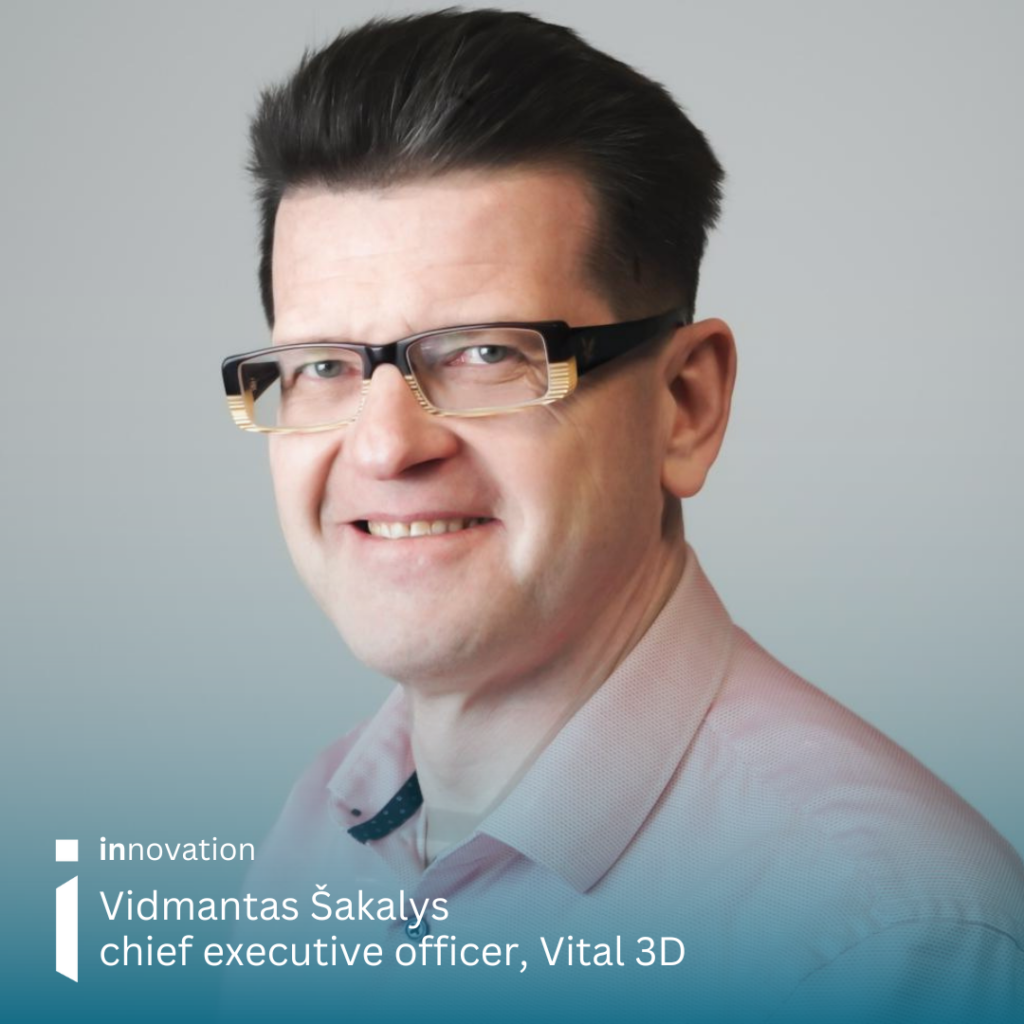“Our goal is to print a kidney in 24 hours”
Written by Julie Penfold, RARE Revolution insider
Interview with Vidmantas Šakalys, chief executive officer, Vital 3D
Estimated reading time: 6 minutes

Vidmantas Šakalys is chief executive officer of Vital 3D, a Lithuanian biotechnology company that is working towards its long-term goal of printing a kidney in 24 hours. Their second focus is centred on developing easy-to-use organoid scaffolds for cancer research, and providing enhanced 3D structures as a low-cost research and development solution for healthcare and biotech. Julie Penfold recently caught up with Šakalys when he was in the UK to attend Word+ 2025, an international organoid research event
Vital 3D’s primary goal to print a kidney in 24 hours is certainly an ambitious one, but is it a realistic aim? Šakalys says it is.
Bioprinting innovation
“Our primary idea is to develop the technology to print a kidney and then to print it quite fast, within 24 hours,” he says. “Currently, you cannot bioprint within two weeks and as you are working with live cells and they need to be fed for them to stay alive.
“At the moment, we already have a technology that is able to bioprint scaffolds that are of one micron precision, and this is enough for bioprinting. We are now entering the second phase and we’re starting to bioprint together with live cells,” he explains.
“Up until now we just printed from polymer and then seeded the cells onto the scaffolds. But this year, our target is to start to print the scaffolds from bio ink (to produce artificial live tissue using 3D printing). This is where the polymers are mixed with live cells to produce small tissues at the beginning.
“We are targeting currently to use artificial skin at the beginning to test the skin printing and later on we will move into vasculature skin printing. It’s a step-by-step progress that is slow but we’re gradually moving towards the goal.”
Vital 3D’s ambitious approach to improving healthcare research and patient care is very much in step with its country’s bold research and development (R&D) aims. Lithuania has gained an international reputation for its advanced research in the fields of biotechnology, pharmacology and biomedicine, for example.
Organoid scaffolds for cancer research
As Vital 3D is a commercial entity, he says, they need to work faster on their goal than the anticipated 15 year wait there is for the first 3D printed organ to become available.
“We need to do it in a couple of years (work towards printing a kidney) and we have already started to work from bioprinted skin,” he says. “Our target is in the next year to have the live product ready for skin regeneration. We are starting from veterinary applications and then next steps will be adopting the same bioprinted skin for skin regeneration for humans.”
Their second focus is centred on developing easy-to-use organoid scaffolds for cancer research. Šakalys tells us more.
“With our technology, what we can do is fully take control over the scaffold architecture and what we’re aiming to do here is to create vascularized scaffolds for the organoid growth. Currently, the organoids are grown accidentally when the cells randomly collect so our target is to introduce the scaffold with a vascularised structure. This will help to unclog the cells as there will be extracellular matrix for them to stick to.”
He adds offering vascularised scaffolds will avoid any necrosis developing in the middle as nutrition will reach each individual cell. “Our target is for the organoids to become more uniform and healthier for use in cancer research.”
Vital 3D’s organoids are currently being tested at the National Cancer Institute in Lithuania. “We are working with them to develop the architecture that would impact the research using cancer cells as they usually do not like to form organoids at all,” he explains.
“What the National Cancer Institute has found is these cancer cells that usually do not form any organoids are starting to collect into organoids on our scaffold,” Šakalys says. “This now allows us to start researching in more detail these cancer lines that usually are difficult to research.”




Potential impact on patient care
Vital 3D’s ceo is also passionate when he talks about how bioprinting technology is poised to impact healthcare and scientific research in the coming years.
“Bioprinting has unlimited possibilities to help with this,” he says. “For example, from printing the specific skin, tissues or organs for replacement in patients, to taking specific disease-affected cells and bioprinting them into larger tissue to enable the adjustment of drug quantities or to heal that specific disease.”
In addition, patients could receive more bespoke and safer treatments, he adds. “You can take the cells and bioprint some tissue from that specific patient or you can test drugs and drug amounts on that skin tissue. Clinicians could then provide to their patients already adjusted amounts of the drugs that are targeted to specific disease. There really are a lot of potentials for bioprinting impact in patient care.”
The most obvious of these is organ transplant, he says, and although this advent is still in the distance currently, bioprinting smaller tissues can be a step in the right direction.
“With our technology where we can very precisely print specific architecture, we can bioprint this for directional neuron growing,” he explains. “For example, the scaffold can guide two neurons to each other to start restoring neural connections. There are really interesting possibilities for applications of this technology in healthcare.”
Vital 3D is also working on a bioprinting solution for osteoporosis, a bone disease which affects 3.5 million people in the UK alone. According to the Royal Osteoporosis Society, osteoporosis-related fractures are the fourth greatest cause of premature death and disability. In the UK, the NHS spends £4.5 billion annually on managing osteoporotic fractures.
“For bone disease research, you don’t need to use live cells, so this opens up many possibilities,” Šakalys explains. “For example, osteoporosis could be healed faster by bioprinting specific organoids that have been enriched with growth hormones. These could then be inserted into the location where a patient’s broken osteoporosis bones are situated.”
The team are currently discussing getting started with this project with the Innovative Medicine Centre in Lithuania.
Connect with Vidmantas
innovation spotlights the future of RARE through a technological lens. To access more innovation articles click below.

